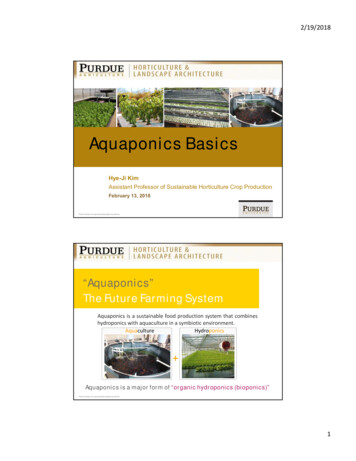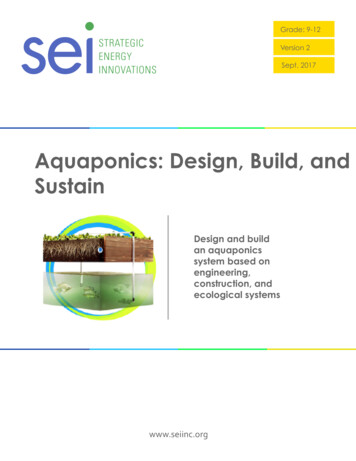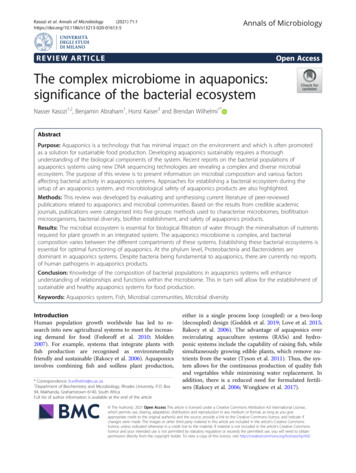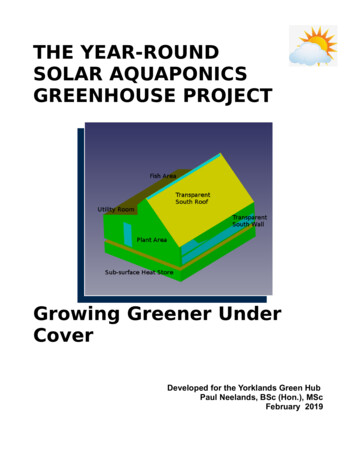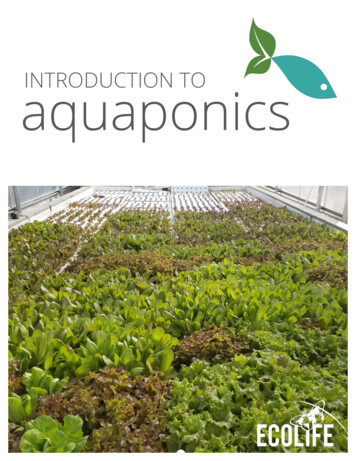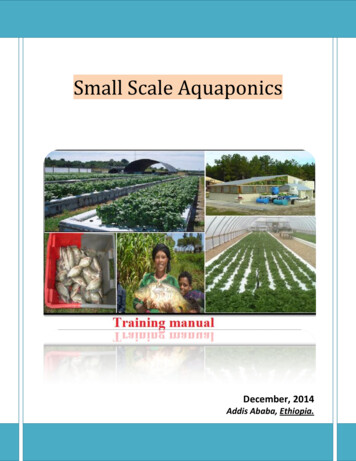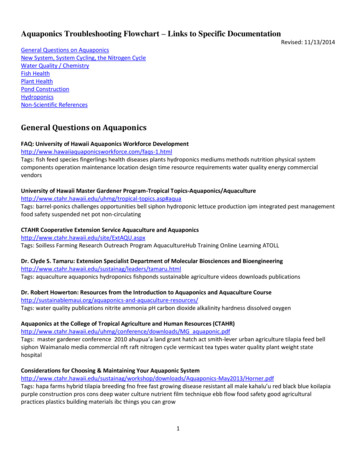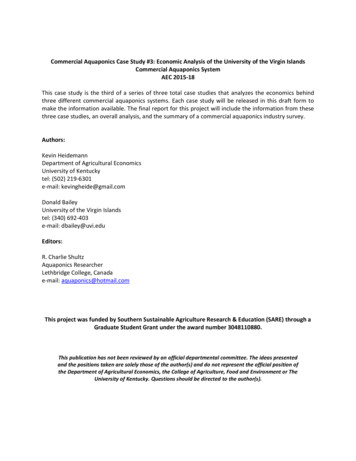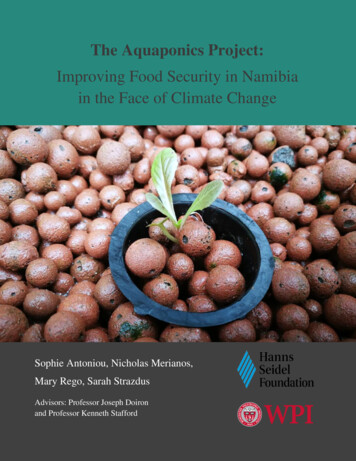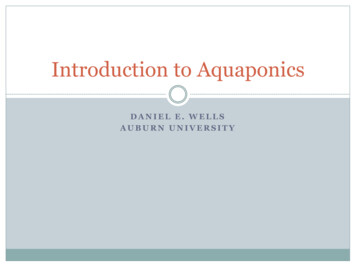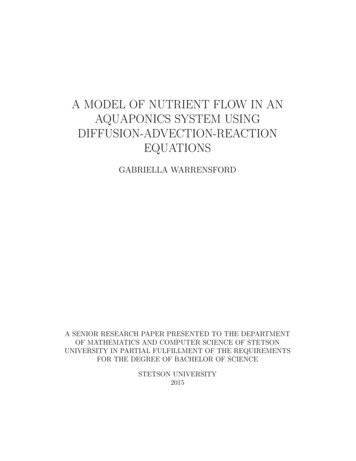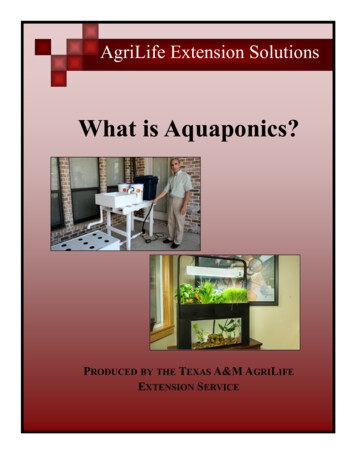
Transcription
AgriLife Extension SolutionsWhat is Aquaponics?PRODUCED BY THE TEXAS A&M AGRILIFEEXTENSION SERVICE
AgriLife Extension SolutionsWhat is Aquaponics?Written byTodd Sink, Ph.D.Assistant Professor and Extension Fisheries SpecialistDepartment of Wildlife and Fisheries ScienceTexas A&M AgriLife Extension ServiceTexas A&M UniversityJoseph MasabniExtension Small-Acreage Vegetable SpecialistDepartment of Horticultural SciencesTexas A&M AgriLife Extension ServiceTexas A&M Overton Research and Extension CenterJune 20, 2016Produced by the Texas A&M AgriLife Extension Service
AgriLife Extension SolutionsThe word aquaponics is the combination of two words, aquaculture and hydroponics. Aquaculture isthe science of raising fish and hydroponics is the science of growing plants in a soilless media. Therefore, aquaponics is the combination of those two food production systems into one.Most of the world’s aquaculture production takes place in earthen ponds or raceways, and these systems are static or flow through. Fish in these systems produce nitrogenous and mineral wastes which requireextensive filtration. In hydroponics, inorganic fertilizers are used as the source of nutrients for plants, whichrequires flushing the system on a regular basis to replenish the fertilizer solution or to remove excess salt accumulation. In an aquaponics system, ammonia (NH3) excreted by fish as a waste product from protein metabolism is converted to nitrate (NO3-) by nitrifying bacteria so it may be used by plants. Plants act as a water filtration system by absorbing nitrogenous and mineral wastes to improve water quality for the fish. Fish, nitrifying bacteria, and plants benefit each other. The fish are the source of nutrients for the plants, nitrifying bacteria convert fish waste products to usable forms for the plants, and plants filter nutrients from the water to benefit the fish (Figures 1 and 2).Figure 1. Schematic representation of an aquaponics systemThus, aquaponics is a unique ecosystem within a food production system, where fish, bacteria, andplants are mutually benefiting each other. In other words, aquaponics is the combination of both intensive aquaculture and hydroponic production systems in a recirculating water system.The immediate benefits of aquaponics are reduced costs of fish waste filtration by conventionalmethods, and more importantly, inorganic fertilizersand associated costs of fertilization management areno longer required. An aquaponics system requires thefollowing inputs: water, fish feed, electricity for thewater and air pumps, and light. Advantages of such asystem are it is 100% organic since no syntheticchemicals are used, fast and efficient food production,low water consumption, and less filtration equipmentand costs are required as plants act as filters. AnotherFigure 2. Backyard aquaponics model with room for 12plants.Produced by the Texas A&M AgriLife Extension Service1
AgriLife Extension Solutionsadvantage is the harvested plants remain alive since the roots are not cut at harvest. Live plants store longer inthe refrigerator, remaining crisp and still taste well 2 weeks later (Figure 3). Plants stored in a refrigerator for2 weeks have been removed, planted in a garden, and started growing again, thus demonstrating the plantfreshness retained by harvesting in this manner.It can be easy for existing hydroponics producers to convert a hydroponic system into an aquaponicsystem. Conversion of a hydronic system means the addition of one or more tanks for filtration, a fish tank,some extra PVC plumbing, and the old system becomes a new aquaponic system.The most crucial component of an aquaponics is the nitrifying bacteria. Conversion, or nitrification, of ammonia excreted by fish does not occur automatically. Two genera, or types, of bacteria act in stages to convert fishwaste into usable nutrients for the plants. While fish produce the fuel to run the system, bacteria are consideredas the engine running the aquaponics system. Daily maintenance activities revolve around maintaining an optimal environment for the bacteria while daily water quality measurements indirectly measure the health of thebacteria.The two types of bacteria are, Nitrosomonas and Nitrobacter. Nitrosomonas convert ammonia which ishighly toxic to fish to nitrite which is slightly less toxic to fish. Nitrobacter then convert nitrite to nitrate,which is relatively non-toxic to fish and is the most available form of nitrogen available for plant uptake. Ammonia is a natural product of fish protein metabolism. Freshwater fish excrete ammonia from their gills and infeces. Excessive concentrations of un-ionized ammonia in water are toxic to fish. The amount of un-ionizedammonia in the water depends upon the total ammonia nitrogen (TAN) present and the water pH and temperature. Un-ionized ammonia (NH3) is toxic to mostfish species at concentrations of 1 part per million orless. Conversion of ammonia to nitrite by Nitrosomonas slightly reduces the risk of fish toxicity.However, nitrite is not a readily usable form forplant growth. Therefore, Nitrobacter is crucial as itconverts nitrite to nitrate, which is relatively nontoxic to fish and is the nitrogen form easily absorbedby plant roots and is necessary for plant growth.The biotic, or living, components of an aquaFigure 3. Live lettuce plant ready for storage or saleponic system are thus fish, plants, and two genera ofbacteria, all working in unison (Figure 4). The abiotic, or non-living, components of an aquaponic system consist of a fish tank(s), clarifier or solid waste filtrationtank, biofilter, plant growing beds, tanks, or troughs, a water pump, and/or an air pump (Figure 5). There aremany designs currently employed that combine one or more of those basic components in production. Somesystems using ‘low density’ methods may consist of only a fish tank and trough(s). Systems using ‘high densiProduced by the Texas A&M AgriLife Extension Service2
AgriLife Extension Solutionsty’ methods may consist of all the above-mentioned parts plus a media bed. Additional components sometimesused on a commercial scale include a ‘base addition’ tank to add water quality amendments so that fish andplants are not immediately exposed to rapid pH or other water quality changes.Fish tanks, of course, are where the fish are housed. A properly constructed aquaponics system shouldinclude at least two fish tanks. Some large commercial operations have four or more fish tanks. Two fish tanksare strongly encouraged for even backyard type systems. Two tanks are beneficial for many reasons.Separating fish of various sizes reduces the risk ofcannibalism. With a single fish tank, you cannotharvest the entire tank at once without the risk ofrunning out of nutrients for the plants. With twofish tanks, all fish in one tank may be harvestedquickly, efficiently, and economically, while continuing to supplying nutrients for the plants fromthe other fish tank. Partial fish harvest and replacement with fingerlings increases the risks for lossesdue to cannibalism for many species, so it may notbe feasible to have a single tank for some species. AFigure 4. The aquaponic nitrogen cycleminimum of two fish tanks is the ideal solution.Imagine you have two fish tanks and with fingerlings in one and medium-sized fish (about ½ lb.) inthe other. When the larger fish mature and are ready for sale or consumption, usually at about 1 lb., then thefingerlings are now ½ lb. Adding fingerlings in the tank that was just harvested will bring you back to whereyou started: one fish tank with fingerlings, the other with mid-size fish. Depending on your greenhouse size orthe size of the troughs, fish tanks can range from a 100-gal tank to a 1500-gal tank. Most commercial aquaponics startups do not consider fish as part of the business plan. A common myth exists that aquaponics is cheaperthan hydroponics. This is not the case. One ton of 32% fish feed costs about 485 and supplies 305 lbs. of nitrate. A similar amount of nitrate supplied from urea in a hydroponics system costs only 107. If you plan torun a commercial aquaponics operation, fish must be sold to cover operational costs. Finally, some fish speciesare poor choices in aquaponics. Examples are catfish, bluegill, and goldfish or any other non-food fish withlimited sales outlets. Best choices are tilapia, hybrid striped bass, and rainbow trout in northern climates or as arotational winter crop with tilapia in summer, and koi, but only where there is a significant retail outlet forlarge koi.The clarifier or solid waste filter comes in many shapes and under different names, such as radial filter,swirl filter, solids settling tank, or clarifier. The main function of the clarifier is to separate the solid wasteProduced by the Texas A&M AgriLife Extension Service3
AgriLife Extension Solutionsfrom the nutrient rich water (Figure 6). Most clarifiers rely on reduced water and gravity to settle solid waste atthe bottom of tanks to be drained out on a regular basis.Figure 5. Schematic representation of an aquaponics systemSome systems employ two clarifier tanks in series (Figure 7) to remove most, if not all, the solid waste.This solid waste is not truly a ‘waste’. It is still rich in nutrients and should be used efficiently insteadof being disposed of. The solid waste can be aerated for a few days, filtered and the resulting ‘compost tea’ canbe put back in the water of the aquaponic system. The filtered compost tea can also be used as fertilizer in thegarden. Alternatively, the solid waste can be added to a vermicompost bin as a source of food for the worms(Figure 8).The biofilter is where large populations of nitrifying bacteriaare housed on inert media with high surface area. The biofilter is themajor site of conversion of ammonia to nitrites and nitrates. Thereare many approaches to building a biofilter as long as there is a verylarge surface area of inert media in contact with the water. There arealso numerous biofilters available commercially. Ammonia conversion becomes more efficient with every increase of surface area provided by the media. Nylon or PVC bird netting, lava rock, polyethylene filter pads, biomatrix pads, polyester filter fiber, floating orsinking plastic beads, fine-pore porcelain, and various other plasticmedia including bio-balls, bio-barrels, bio-stars, and bio-tubes areFigure 6. Schematic diagram of a claricommonly used. Once the system is operational and has ‘matured’,fier tank for solid waste separationnitrifying bacteria can be found on every inert surface exposed tosufficient oxygen and little organic debris, including the growingtroughs, attached to plant roots, in the pipes, and on all other tanks. Still, the majority of biofiltration, or ammonia conversion, will take place in the biofilter. Commercial units are available that combine the clarifier andbiofilter in a single unit, although it is preferable to keep solid wastes separate from areas containing nitrifyingbacteria. Some operations use a media bed as a bio-solid digestion (Figure 9). Media beds can be planted alsoso as not to waste valuable space.Produced by the Texas A&M AgriLife Extension Service4
AgriLife Extension SolutionsThe base-additional tank serves the purpose of an addition point to add water amendment productswhen adjusting the pH of the aquaponics system. The alkalinity and pH of water in an aquaponic system tends to decrease over timedue to consumption of utilization of carbonates during bacterial processes and plantgrowth. Decreases in pH can be rapid, especially after a rain event adds a large volume ofwater to the system. The water pH should bechecked regularly and adjusted by adding abase to bring the pH as close to neutral, pH 7,as possible. Chemical bases such as calciumcarbonate (CaCO3), calcium hydroxide (Ca(OH)2), calcium oxide (CaO), or potassiumbicarbonate (KHCO3) are available.Figure 7. Two clarifier tanks connected in series. First one relies onCrushed oyster shells, a form of calciumcarbonate, are also popular among smallscaleoperations or with homeowners. Oystershells in a mesh bag submerged in the tank will act as a buffer and slowly and continuously adjust the waterpH, but may not be sufficient alone.Growing troughs or tanks are where plant production occurs. There are currently three types of troughs usedin aquaponics. Media beds are filled with a media, such asexpanded clay pellets or pH neutral rock, and are usuallyoperated using the flood and drain method (Figure 10). Themedia bed is set to fill with water during a 20 minute interval, then a float-valve, inverted siphon, or other drainmechanism is activated and the water is drained over a 10minute interval. This continuous flood and drain cycleguarantees the plant roots never become too dry or wet fortoo long. Expanded clay is expensive and many growers tryto use other material like pea gravel or crushed granite. It isimportant to use pH neutral rock alternatives. To test if therock is pH neutral, add vinegar t a small amount of rockand if it starts bubbling, the rock is not suitable for an aquaponics system no matter how well it is washed before use.Figure 8. Earthwormsin a media bed made ofcrushed granite, actingas another step for solidwaste filtration.Produced by the Texas A&M AgriLife Extension Service5
AgriLife Extension SolutionsThe advantage of a media bed is that larger plants orfruiting vegetables can be grown in this media. The expandedclay acts as a physical support for the roots of those largeplants. The disadvantage of media beds is that large areas canbecome clogged creating anoxic areas, so frequent cleaning ofthe media is often required.The second type of growing trough uses the nutrientfilm technique (NFT) currently adopted in hydroponics operations. PVC pipes, gutters, or similar material can be used forsystem construction (Figure 11). In this system, a thin layer ofFigure 9. Media bed for solidwater is continuously running through the pipes and the plantswaste filtrationroots are continuously exposed to nutrient rich water. No additional aeration is needed. This system is suitable for smallsized plants such as leafy greens. Larger plants will have larger roots which will clog the pipes or gutters. Onedisadvantage of the NFT is that water temperature can warm up very easily due to smaller volumes and thinsheets of water. However, with the addition of water chillers, lettuce production using NFT can be done yearround.Figure 10. Flood and drain trough filled with expanded clay (left) or crushed granite (right).The third and most popular type of growing trough is the deep water raft culture system or DWRC(Figure 12). In this system, a rigid closed-cell foam board floats on the surface of relatively deeper troughs thatare continually filled with water, and started plants are placed into holes in the foam board so the roots are submerged in water. Supplemental aeration from air stones and an air pump is absolutely vital for the planttroughs in the DWRC system. Troughs can be as shallow as 6 inches and as deep as 24 inches, although 18inches is the typical standard. Troughs don’t have to be on the ground; the troughs can be built on a bench orProduced by the Texas A&M AgriLife Extension Service6
AgriLife Extension Solutionstable but caution should be observed as the water weight can besubstantial. The DWRC system isvery popular among commercialoperations specializing in leafygreens such as lettuce and kale.In a typical aquaponicssystem, the fish tanks are thehighest point in terms of waterFigure 11. Various crops grown in a NFT systemlevel. Water cascades from thefish tank, to the clarifier(s), to the biofilter, to the supplemental aeration tank, to the growing trough (Figure13).The base addition tank is usually located at or near thereturn pump at the end of the culture troughs, which is the lowestwater level in the system. A water pump is hence necessary topush the water back up to the fish tank. This is normally the onlywater pump necessary in an aquaponics system, although airliftsystems require no pump. Airlift systems utilize the blower supplying air to the fish and plants to return water to the fish tanks.When purchasing a water pump, keep in mind that the flow rating is for a pump pushing water horizontally. If the pump has toFigure 12. Deep water raft culturepush water up or vertically, the flow rating drops significantly.with lettuce at various stages ofFor example, a water pump rated at 500 gph can push water angrowthelevation of 3 ft at 300 gph only. This is why most pumps carry agraph of flow rate in gallons per hour versus head height. Whenchoosing a water pump, select one that can circulate the entire volume of water in the entire system at the totalsystem head a minimum of 3 times per day. For example, in a system with 1000 gallons of water total, and a500 gph pump pushing 300 gph water up 3 ft of head, you achieve a complete turnover every 3.3 hours, or 7.2times per day.An air pump or blower is the only other component utilizing electricity. The air pump should be connected via pressure tubing to airstones placed in the bottom of the fish tank(s) and growing trough(s).One final component, not commonly considered when building an aquaponics system but is of utmostimportance, is a backup generator. In case of power outage, plant roots can survive low oxygen levels forabout 12-24 hours without significant damage. On the other hand, fish can suffocate in as little as 30 minutesto 4 hours depending on stocking density after a power outage.Produced by the Texas A&M AgriLife Extension Service7
AgriLife Extension SolutionsFigure 13. Cascading flow ofwater from fish tanks totrough (not shown).In summary, aquaponics offers many advantages to the homeowner or commercial producer. Aquaponics serves a dual purpose ofproducing both fish and plants as food. Plants in an aquaponics systemtend to grow faster than in an open field and utilize about 10% of thewater needed. Most importantly, aquaponics produces fresh healthyvegetables that were not treated with any chemical pesticide or inorganic fertilizer. Aquaponics is not restricted to commercial operations.Many homeowners are enjoying home-scaled systems for their personal enjoyment and consumption (Figure 14).Figure 14. Backyard system using barrels as growing beds (left) and home system with an aquarium (right).Photo CreditsRex Byrns. Megan’s Gardens. Victoria, TXAdam Cohen. Green Phoenix Farms. www.greenphoenixfarms.comJack Ikard. Aquasprouts Co. www.aquasprouts.comJohn Jifon. Associate Professor. Texas A&M Weslaco Research and Extension Center.Clint Kripki. Mercury Weather LLC. www.emeraldaquaponicfarm.comDaniel Leskovar. Resident Director and Professor. Texas A&M Uvalde Research and Extension Center.Joe Masabni. Extension Small-Acreage Vegetable Specialist.Produced by the Texas A&M AgriLife Extension Service8
Jun 20, 2016 · system. Conversion of a hydronic system means the addition of one or more tanks for filtration, a fish tank, some extra PVC plumbing, and the old system becomes a new aquaponic system. The most crucial component of an aquaponics is the nitrifying bacteria. Conversion, or nitrification, o
